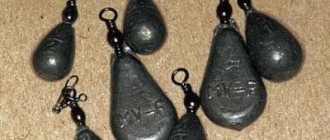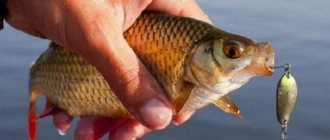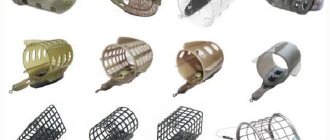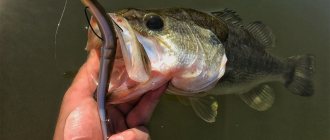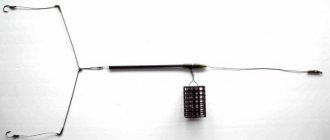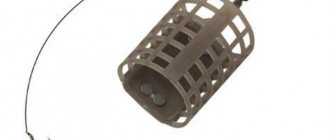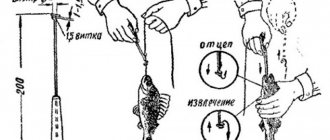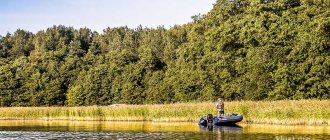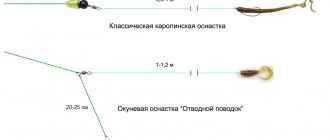Types and types
Sinkers are actively used in spinning fishing. The most common:
Jig heads to which soft baits are attached. They are usually classified as a separate type of gear.
Jig sinker , called a “eared” weight or “Cheburashka”, is a spherical or other shaped weight cast from lead, with two wire loops sticking out in different directions. The bait is attached to one loop, and a cord or leash is attached to the other.
The “bullet” weight received this name because of the similarity of its shape to a real bullet. The main purpose of this form of cargo is to maximize the throughput of the equipment. This sinker is used in Carolina rig and Texas rig.
The design of the load for a particular spaced equipment is dictated by its specifics. The bait is not attached to the weight; it is tied at the end of the leash. The load has one attachment point, designed in the form of a special clamp. Sometimes a swivel is used instead of a clamp.
Shapes of sinkers
Next, let's look at the different shapes of sinkers:
- cubic - provide good self-notching, the edges do not allow deep burrowing into the silt
- frame ones - have proven themselves well when bottom fishing in the current.
- airplanes - when fishing for fish or pulling a rig out of the water, due to their shape, they come off the bottom, which eliminates dragging.
- swept - have excellent aerodynamics for long casts
- spindle-shaped - more suitable for pickerel fishing
- three-bladed - do not provide long casting distances, but slowly sink to the bottom. Ideal for muddy ponds.
Materials
Different manufacturers of fishing sinkers have different material compositions. The basis of most sinkers used today is lead, to which antimony or bismuth is added in small quantities for rigidity.
In addition, there are sinkers made of a special material filled with tungsten powder. It is very soft and allows you to form a sinker of the required shape.
Also, based on environmental considerations and the possibility of not only casting bullet sinkers, brass and steel are often used as materials for them. Sinkers made from non-lead are especially popular abroad.
Why are Sinkers needed?
Sinkers for Float Rods come in different shapes and sizes (it all depends on the size of the fishing line and the size of the float) and are used depending on the nature of the reservoir, whether there is standing water in it or running water.
When fishing with a float rod, sinkers are most often used from several pellets or a thin strip of sheet lead wound onto a fishing line with a tube.
The pellets are cut to their middle, a fishing line is inserted into the cut, and then the pellet is compressed with pliers. This must be done carefully so as not to damage the fishing line by pressing hard, otherwise it may break during fishing.
There are usually several such pellets, with the lowest one being the smallest, while the rest are attached higher at a distance of 5 - 7 cm from one another.
It is necessary that each subsequent pellet be slightly larger than the previous one. It is desirable that the pellets be soft. Split pellets are usually used with a diameter of 2 to 5 mm.
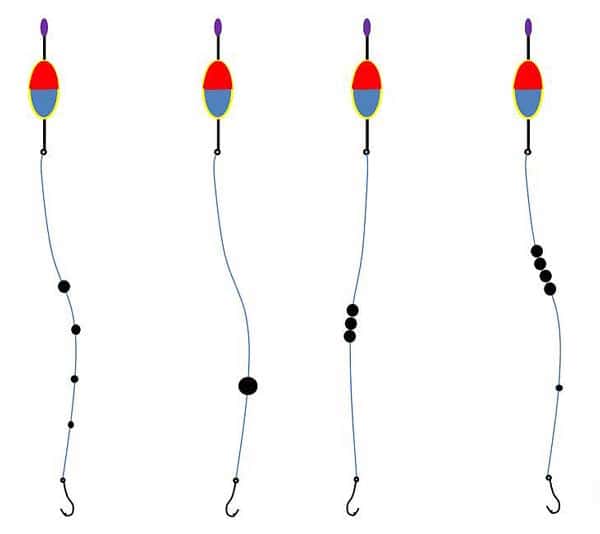
Device for Loading Floats in 20 Minutes. Video
Form
If a bullet load has one shape, many shapes of “eared” loads have been invented. Each of them has some advantages and disadvantages. The usual and most common form of “Cheburashka” is a ball. Due to the physical properties of the ball’s shape, such a load flies well and sinks quickly.
- The bait is attached to one of the loops of the classic “eared” weight using a winding ring.
- The second type of “Cheburashka” is the collapsible weight-heads that have appeared in the last few years, which are a lead ball in which there is a through slit-like hole. The wire ears in such sinkers are an open loop bent from wire, reminiscent of a paper clip. The bait is attached to collapsible weights without the participation of winding rings. The bait is attached directly to the wire loop. To do this, just pull out the loop from the lead, put the eye of the hook on one end of the wire loop and move the bait along the loop to the correct position. Then insert the wire loop, with the bait already attached, back into the lead.
- The third modification of such a load is with a wire bait clasp as one of the “ears”.
The load for spaced equipment can have any shape: “ball”, “drop”, “stick”. The choice of load shape is determined by the preferences of the angler or, more often, by the fishing conditions. In most cases, the goal is the same: to reduce the number of “deaf” hooks on the ground by the load. For this purpose, such forms of cargo as “stick”, “drop” and similar low-clinging forms are used.
Steel leash
The classic and, perhaps, the most reliable option for protection against pike teeth is steel. You can be sure that such a leash will not cut even a piranha. At the same time, this is a considerable bulkiness of the gear, as well as minimal camouflage. A piece of wire, even quite thin, is perfectly visible in water.
And this is almost critical when fishing for perch or pike-perch with chub, but it often fails when fishing for pike. No, of course, the pike is also not blind and not so careless as to attack anything. But the nature of the spinner’s actions when hunting for pike and the reaction of the toothiest one to this allow one to count on success with steel.
Judge for yourself: pike fishing is usually quite aggressive and fast, the bait and jig are very voluminous and massive, the predator’s attack is almost lightning fast. And especially if we are dealing with active specimens that attack immediately, without considering the accessories of the tackle, then the clumsiness of the leash fades into the background, and protection from shearing comes to the fore. Steel is in favor here.
Steel leaders are very common not only in jigging, but even more so when fishing with wobblers. In addition to the fact that few people want to lose their favorite and expensive “toy” during a cut, few people also enjoy untangling treble hooks caught in a soft leash through casting. Yes, it is during twitching that this happens most often, and a rigid steel leash in many ways solves the situation with overlaps perfectly.
Another significant advantage of a steel leash is its ability to cut algae. Where any other leash collects a whole bunch of grass, with a sharp jerk the steel often passes like a knife through butter, and full-fledged wiring can be continued further, rather than dragging all this green stuff to the boat or shore and looking for your bait there.
Classic steel leashes are commercially available in large quantities, but are usually made by hand from a piece of field wire, a guitar string (first or second) or any other steel wire with a diameter not exceeding 0.3-0.4 mm. Better, of course, thinner. The cost of such a leash is cheap and is determined mainly by the price of the fastener and swivel.
However, if the leash is made using the twist type, no additional fittings are required. Unwind the wire, thread the eye of the jig through it and twist it back. A little longer than with a clasp, but cheaper and less cumbersome. The length of the leash is usually standard - from 20 to 30 cm. The manufacturing technology is not particularly complicated, but there are options, so I will omit the nuances.
However, not all steel leashes are clumsy and rough. For several years now, very miniature, soft and elegant steel leashes have been on sale - they are simply called “twists”. At a cost of 2-3 UAH per piece, they have a diameter of 0.15-0.2 mm and a length of 5 to 15 cm. This is, indeed, a compromise between camouflage and reliability from cutting. Of course, such thin things are not used when catching large pike and especially with heavy (from 15 grams) jigs - after all, thin wire is not so strong.
Such miniature twists have no competitors, especially when catching pike, pike perch and perch at the same time. You must admit that there is not always a guarantee that a pike will not slip between the perch, and sometimes you don’t even know which of the predators has chosen the snag closest to the route. Basically, thin and short steel is relevant for coastal spinning players.
Color
Previously, sinkers were simply metal, that is, they had the color of lead. But today you can buy fishing sinkers of any color. Additional coating is applied for two reasons.
- First of all, the coating is a protective layer. With its sharp protrusions, a “naked” sinker, when entangled in snags, can cut even the strongest leash, but on a sinker with a protective coating there are no sharp protrusions.
- Secondly, the coating serves as a kind of camouflage. Since the range of sinker colors is wide, you can purchase a sinker that will perfectly suit any lake bottom.
It is believed that the sinker in the form of a sparkling polyhedron attracts fish from afar with its flickering. Painted white, it does not repel fish as much. White color is the color of the fry of most fish species; it does not alert potential prey, but, on the contrary, helps attract it.
Sinkers on the fishing rod - faithful assistants in loading the float
If you properly load the float, then catching the coveted trophy will not be difficult. Because you will immediately notice the fish touching the bait, and then it’s a matter of technique.
Sinkers on a fishing rod can have different colors. It is believed that light colors of products are not so alarming to fish. In any case, the weights should be secured in such a way that the current does not blow the line into an arc: it is better to place the largest one closer to the float. Also, when making equipment, it is recommended to install silicone cambrics, which help to better secure the fishing line and not damage it.
The length of the equipment should be greater than the depth of the fishing spot, and when using light bloodworm larvae or heavy worms as bait, float weights of different sizes and weights must be placed on the fishing line.
Order high-quality weights on the Proffish website: with their help you can easily adjust the weight of any equipment.
Sinker material for carp fishing
From time immemorial, ordinary lead was used to make fishing sinkers, which could always be “extracted” from lead car batteries. Pb (plumbum) is one of the heaviest metals, which makes it possible to provide sufficient weight to the sinker, with the smallest dimensions. But not everything is so simple!
Since lead is not only an ideal material that provides excellent flight properties (for weights or bullets), but also a toxic substance! That is why our manufacturers still produce lead loads (but, to be on the safe side, they often keep silent about the materials). Then foreign companies (in accordance with strict “Environmental Laws”) switched to (expensive) tungsten, special alloys... and natural stones.
Also read about how to make simple carp sinkers at home? (by Mark Roberts)
Yes Yes. Many owners of private European reservoirs successfully sell to their clients (sometimes “forcibly”) environmentally friendly stone sinkers. Despite a slight decrease in aerodynamic characteristics, they are perfectly camouflaged, since the raw materials for them were actually the same “cobblestones” that lie nearby on the bottom.
Pear-shaped sinker
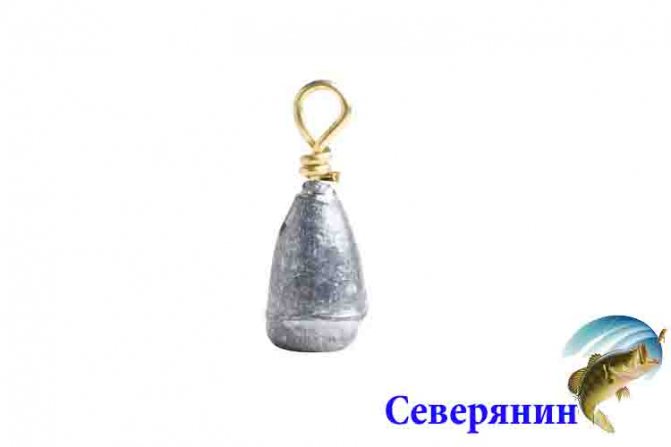
I have used these bell sinkers effectively for casting bass rigs, but this type of sinker is great for shore anglers because it casts well, allowing them to cast their rigs longer distances. When fishing from a boat, you can use a sinker to fish vertically. The round shape of the weight reduces the risk of snagging, so vertical fishing is effective for bouncing along the bottom when rafting in open water.
Loading the float with several pellets
As a rule, to load floats, it is pellet sinkers that are used in a certain quantity, which can reach up to 10 pieces. By correctly selecting the weight and number of pellets, you can place them on the fishing line so that the hook with bait, when immersed, smoothly passes through all the water horizons or, on the contrary, lingers in one of them.
The speed at which the hook and bait fall is controlled by changing the distance between the weights.
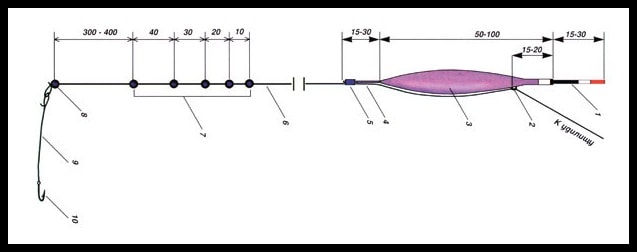
So, if you have a float model with a load capacity of 2 g, then to load it you will need 5-6 pellets with a total weight of the same 2 g. If the load capacity exceeds the mark of 2.5-3 g, then it becomes quite appropriate to use and weights in the shape of olives.
However, do not rush to tightly crimp the sinkers, relying only on the numbers on the packaging. The weight of the sinker and the carrying capacity of the float may be inaccurate, so if possible, it is better to check the load experimentally, that is, by immersing the equipment in water.
It is also worth noting that the weight of the sensitive float is also affected by the hook, so test the weight of your equipment together with it.


